Report on Liquidation of Companies: ABC Learning, HIH, One.Tel (2018)
VerifiedAdded on 2021/06/17
|13
|2779
|334
Report
AI Summary
This report provides a comprehensive analysis of the liquidation of three companies: ABC Learning Company, HIH Insurance Company, and One.Tel Company. It examines the events that led to their financial downfall, including issues of governance, market strategy, and the role of liabilities. The report delves into the specific circumstances of each company, exploring the criticisms, ethical breaches, and financial stress that contributed to their collapse. It investigates whether liabilities were a major factor in the liquidation process, and discusses the consequences for shareholders, the market, and the economy. The analysis covers the companies' codes of conduct, liquidator roles, litigation, and the impact of the liquidations on various stakeholders. The report also provides detailed insights into the events leading up to the liquidation of each company, including key dates, financial figures, and the involvement of regulatory bodies such as ASIC. Finally, it offers a critical assessment of the factors that contributed to the companies' failures, aiming to provide a clear understanding of the complexities of corporate liquidation.

Paraphrase This Document
Need a fresh take? Get an instant paraphrase of this document with our AI Paraphraser
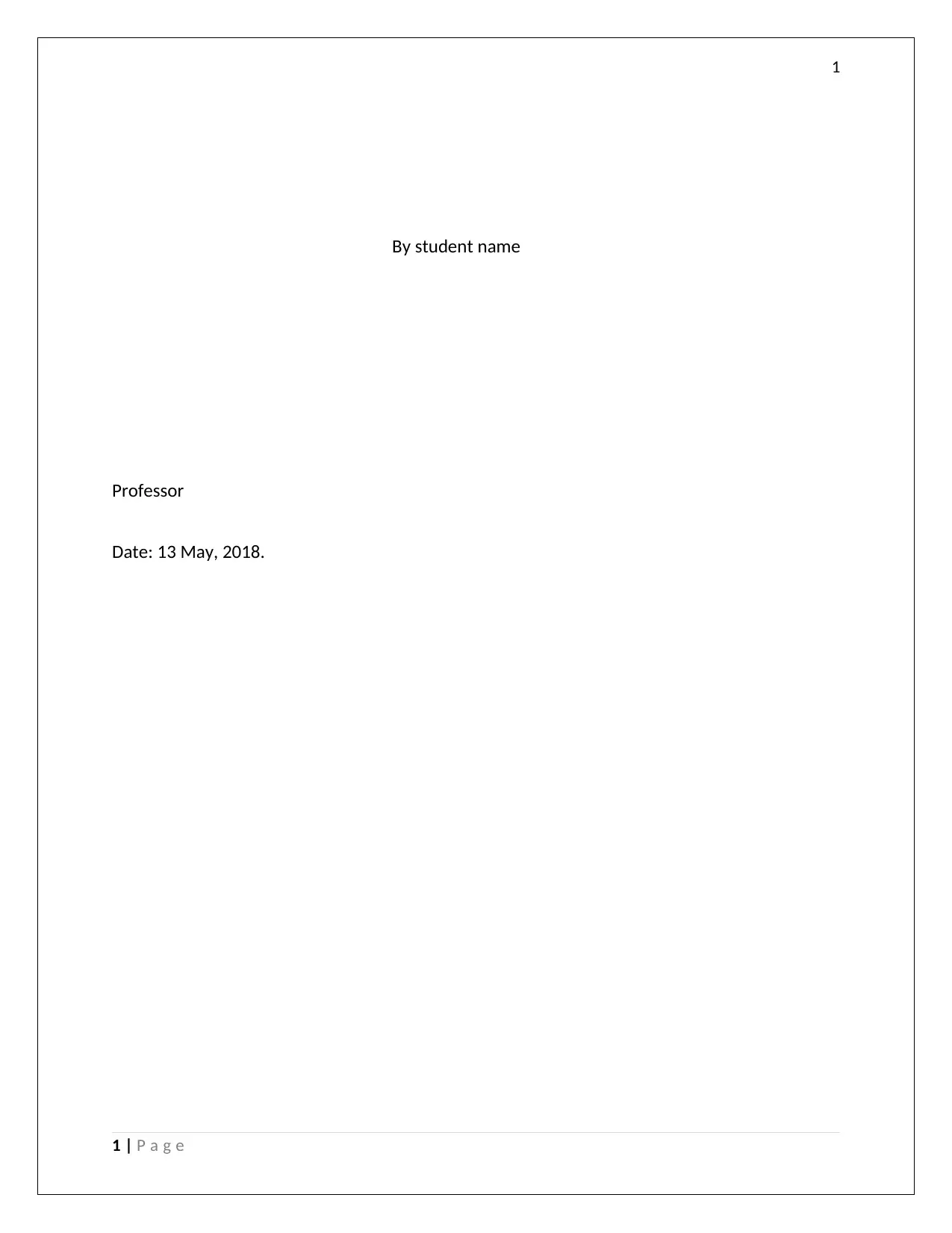
1
By student name
Professor
Date: 13 May, 2018.
1 | P a g e
By student name
Professor
Date: 13 May, 2018.
1 | P a g e
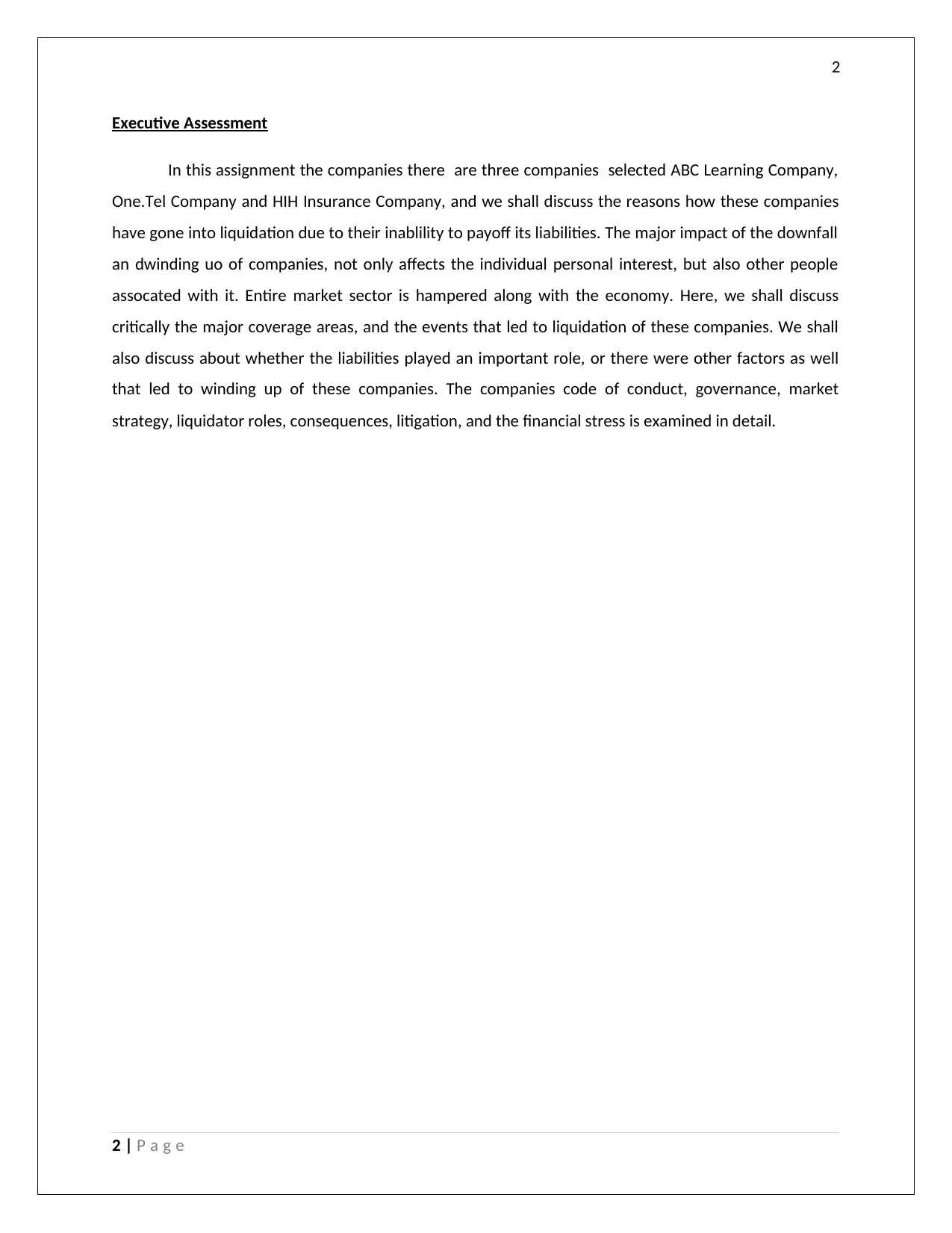
2
Executive Assessment
In this assignment the companies there are three companies selected ABC Learning Company,
One.Tel Company and HIH Insurance Company, and we shall discuss the reasons how these companies
have gone into liquidation due to their inablility to payoff its liabilities. The major impact of the downfall
an dwinding uo of companies, not only affects the individual personal interest, but also other people
assocated with it. Entire market sector is hampered along with the economy. Here, we shall discuss
critically the major coverage areas, and the events that led to liquidation of these companies. We shall
also discuss about whether the liabilities played an important role, or there were other factors as well
that led to winding up of these companies. The companies code of conduct, governance, market
strategy, liquidator roles, consequences, litigation, and the financial stress is examined in detail.
2 | P a g e
Executive Assessment
In this assignment the companies there are three companies selected ABC Learning Company,
One.Tel Company and HIH Insurance Company, and we shall discuss the reasons how these companies
have gone into liquidation due to their inablility to payoff its liabilities. The major impact of the downfall
an dwinding uo of companies, not only affects the individual personal interest, but also other people
assocated with it. Entire market sector is hampered along with the economy. Here, we shall discuss
critically the major coverage areas, and the events that led to liquidation of these companies. We shall
also discuss about whether the liabilities played an important role, or there were other factors as well
that led to winding up of these companies. The companies code of conduct, governance, market
strategy, liquidator roles, consequences, litigation, and the financial stress is examined in detail.
2 | P a g e
⊘ This is a preview!⊘
Do you want full access?
Subscribe today to unlock all pages.

Trusted by 1+ million students worldwide
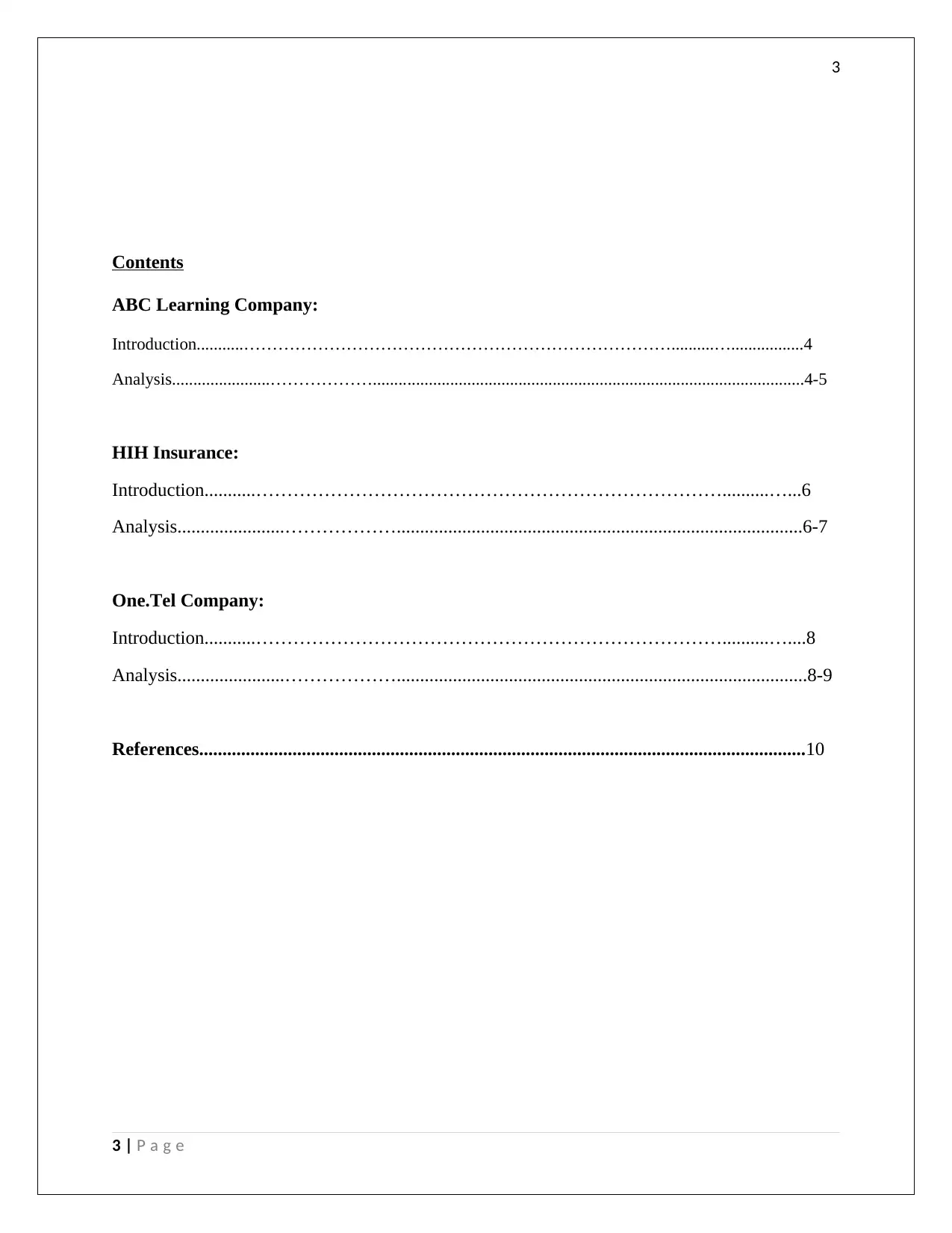
3
Contents
ABC Learning Company:
Introduction...........…………………………………………………………………..........….................4
Analysis.......................……………….....................................................................................................4-5
HIH Insurance:
Introduction...........…………………………………………………………………..........…...6
Analysis.......................……………….......................................................................................6-7
One.Tel Company:
Introduction...........…………………………………………………………………..........…....8
Analysis.......................………………........................................................................................8-9
References..................................................................................................................................10
3 | P a g e
Contents
ABC Learning Company:
Introduction...........…………………………………………………………………..........….................4
Analysis.......................……………….....................................................................................................4-5
HIH Insurance:
Introduction...........…………………………………………………………………..........…...6
Analysis.......................……………….......................................................................................6-7
One.Tel Company:
Introduction...........…………………………………………………………………..........…....8
Analysis.......................………………........................................................................................8-9
References..................................................................................................................................10
3 | P a g e
Paraphrase This Document
Need a fresh take? Get an instant paraphrase of this document with our AI Paraphraser
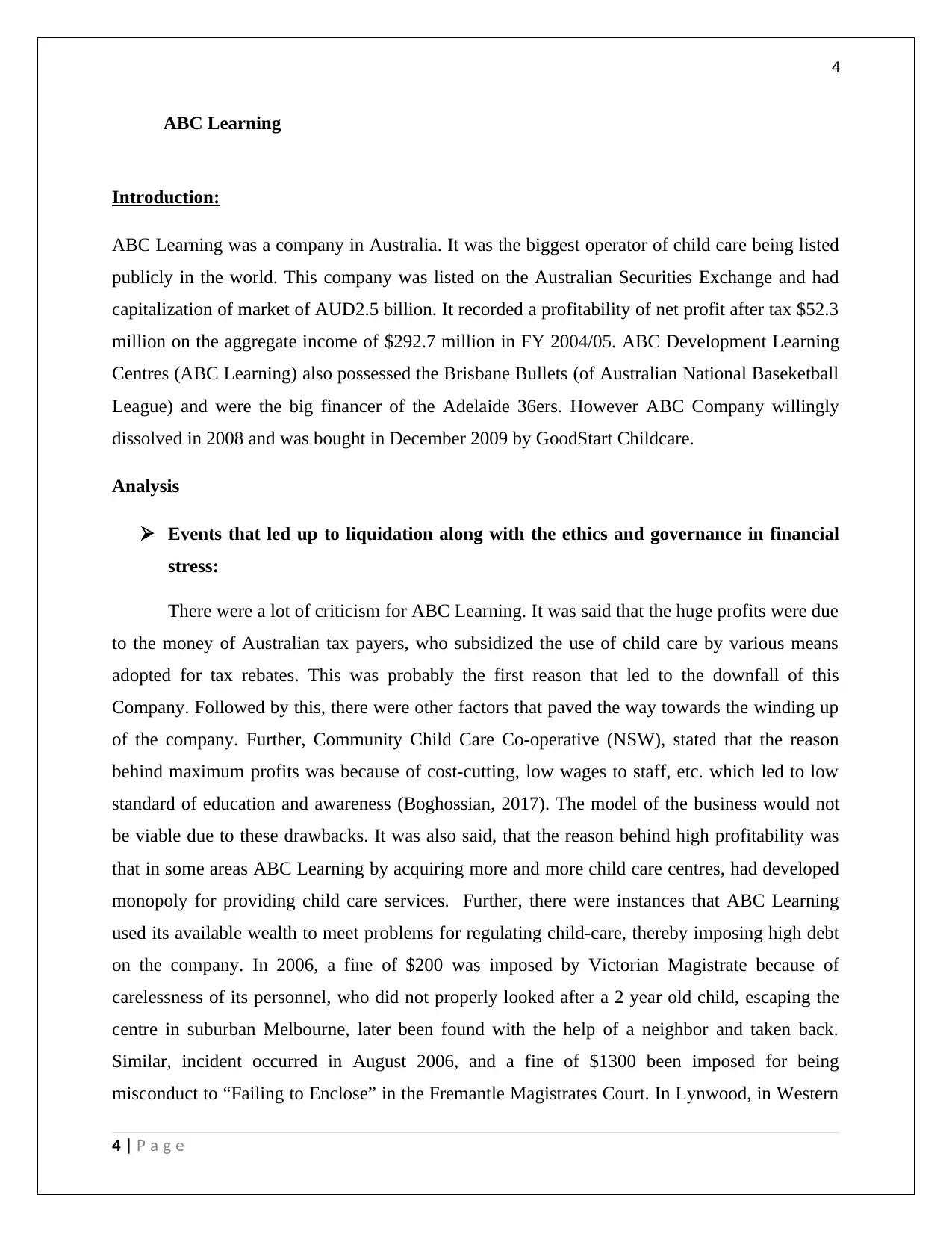
4
ABC Learning
Introduction:
ABC Learning was a company in Australia. It was the biggest operator of child care being listed
publicly in the world. This company was listed on the Australian Securities Exchange and had
capitalization of market of AUD2.5 billion. It recorded a profitability of net profit after tax $52.3
million on the aggregate income of $292.7 million in FY 2004/05. ABC Development Learning
Centres (ABC Learning) also possessed the Brisbane Bullets (of Australian National Baseketball
League) and were the big financer of the Adelaide 36ers. However ABC Company willingly
dissolved in 2008 and was bought in December 2009 by GoodStart Childcare.
Analysis
Events that led up to liquidation along with the ethics and governance in financial
stress:
There were a lot of criticism for ABC Learning. It was said that the huge profits were due
to the money of Australian tax payers, who subsidized the use of child care by various means
adopted for tax rebates. This was probably the first reason that led to the downfall of this
Company. Followed by this, there were other factors that paved the way towards the winding up
of the company. Further, Community Child Care Co-operative (NSW), stated that the reason
behind maximum profits was because of cost-cutting, low wages to staff, etc. which led to low
standard of education and awareness (Boghossian, 2017). The model of the business would not
be viable due to these drawbacks. It was also said, that the reason behind high profitability was
that in some areas ABC Learning by acquiring more and more child care centres, had developed
monopoly for providing child care services. Further, there were instances that ABC Learning
used its available wealth to meet problems for regulating child-care, thereby imposing high debt
on the company. In 2006, a fine of $200 was imposed by Victorian Magistrate because of
carelessness of its personnel, who did not properly looked after a 2 year old child, escaping the
centre in suburban Melbourne, later been found with the help of a neighbor and taken back.
Similar, incident occurred in August 2006, and a fine of $1300 been imposed for being
misconduct to “Failing to Enclose” in the Fremantle Magistrates Court. In Lynwood, in Western
4 | P a g e
ABC Learning
Introduction:
ABC Learning was a company in Australia. It was the biggest operator of child care being listed
publicly in the world. This company was listed on the Australian Securities Exchange and had
capitalization of market of AUD2.5 billion. It recorded a profitability of net profit after tax $52.3
million on the aggregate income of $292.7 million in FY 2004/05. ABC Development Learning
Centres (ABC Learning) also possessed the Brisbane Bullets (of Australian National Baseketball
League) and were the big financer of the Adelaide 36ers. However ABC Company willingly
dissolved in 2008 and was bought in December 2009 by GoodStart Childcare.
Analysis
Events that led up to liquidation along with the ethics and governance in financial
stress:
There were a lot of criticism for ABC Learning. It was said that the huge profits were due
to the money of Australian tax payers, who subsidized the use of child care by various means
adopted for tax rebates. This was probably the first reason that led to the downfall of this
Company. Followed by this, there were other factors that paved the way towards the winding up
of the company. Further, Community Child Care Co-operative (NSW), stated that the reason
behind maximum profits was because of cost-cutting, low wages to staff, etc. which led to low
standard of education and awareness (Boghossian, 2017). The model of the business would not
be viable due to these drawbacks. It was also said, that the reason behind high profitability was
that in some areas ABC Learning by acquiring more and more child care centres, had developed
monopoly for providing child care services. Further, there were instances that ABC Learning
used its available wealth to meet problems for regulating child-care, thereby imposing high debt
on the company. In 2006, a fine of $200 was imposed by Victorian Magistrate because of
carelessness of its personnel, who did not properly looked after a 2 year old child, escaping the
centre in suburban Melbourne, later been found with the help of a neighbor and taken back.
Similar, incident occurred in August 2006, and a fine of $1300 been imposed for being
misconduct to “Failing to Enclose” in the Fremantle Magistrates Court. In Lynwood, in Western
4 | P a g e
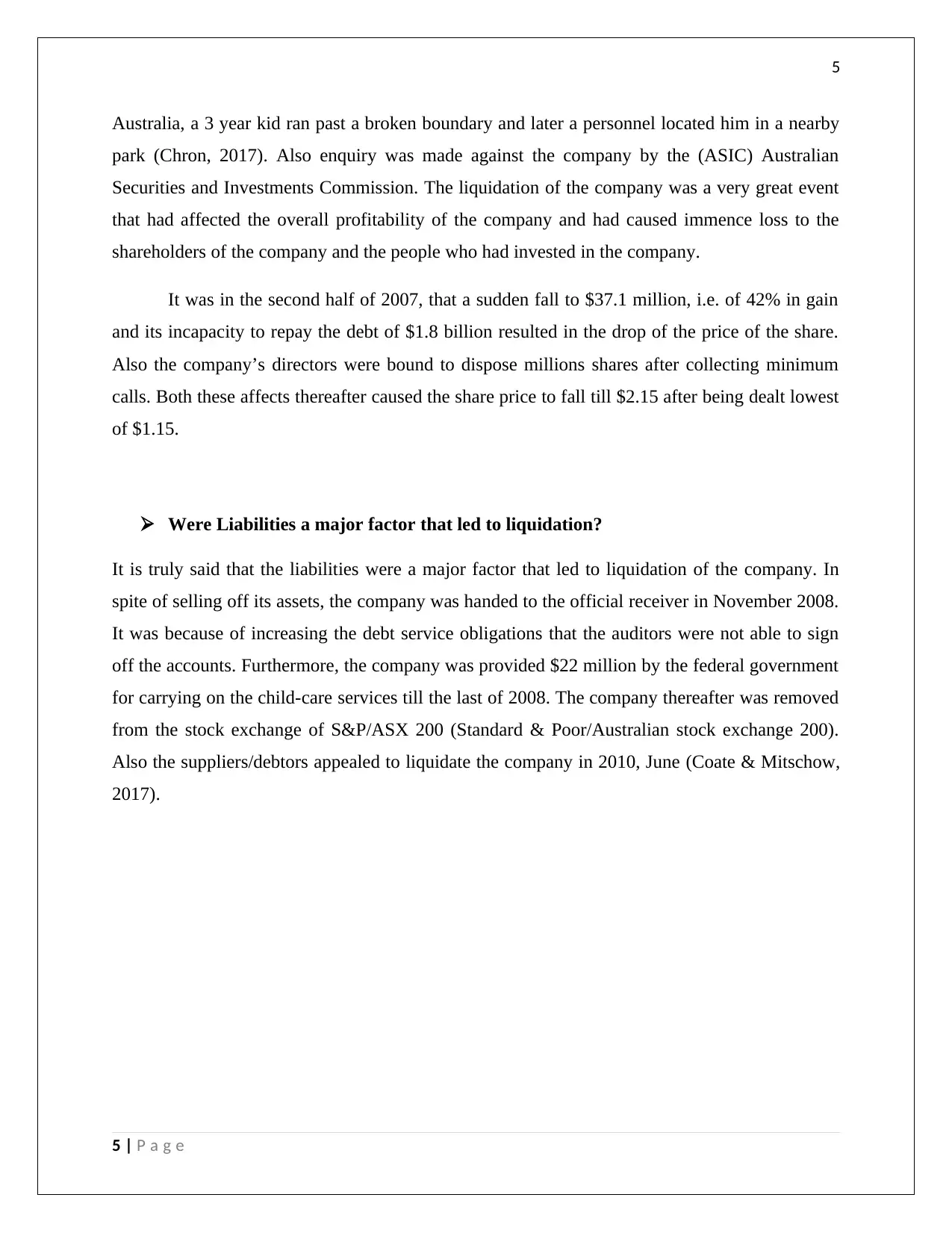
5
Australia, a 3 year kid ran past a broken boundary and later a personnel located him in a nearby
park (Chron, 2017). Also enquiry was made against the company by the (ASIC) Australian
Securities and Investments Commission. The liquidation of the company was a very great event
that had affected the overall profitability of the company and had caused immence loss to the
shareholders of the company and the people who had invested in the company.
It was in the second half of 2007, that a sudden fall to $37.1 million, i.e. of 42% in gain
and its incapacity to repay the debt of $1.8 billion resulted in the drop of the price of the share.
Also the company’s directors were bound to dispose millions shares after collecting minimum
calls. Both these affects thereafter caused the share price to fall till $2.15 after being dealt lowest
of $1.15.
Were Liabilities a major factor that led to liquidation?
It is truly said that the liabilities were a major factor that led to liquidation of the company. In
spite of selling off its assets, the company was handed to the official receiver in November 2008.
It was because of increasing the debt service obligations that the auditors were not able to sign
off the accounts. Furthermore, the company was provided $22 million by the federal government
for carrying on the child-care services till the last of 2008. The company thereafter was removed
from the stock exchange of S&P/ASX 200 (Standard & Poor/Australian stock exchange 200).
Also the suppliers/debtors appealed to liquidate the company in 2010, June (Coate & Mitschow,
2017).
5 | P a g e
Australia, a 3 year kid ran past a broken boundary and later a personnel located him in a nearby
park (Chron, 2017). Also enquiry was made against the company by the (ASIC) Australian
Securities and Investments Commission. The liquidation of the company was a very great event
that had affected the overall profitability of the company and had caused immence loss to the
shareholders of the company and the people who had invested in the company.
It was in the second half of 2007, that a sudden fall to $37.1 million, i.e. of 42% in gain
and its incapacity to repay the debt of $1.8 billion resulted in the drop of the price of the share.
Also the company’s directors were bound to dispose millions shares after collecting minimum
calls. Both these affects thereafter caused the share price to fall till $2.15 after being dealt lowest
of $1.15.
Were Liabilities a major factor that led to liquidation?
It is truly said that the liabilities were a major factor that led to liquidation of the company. In
spite of selling off its assets, the company was handed to the official receiver in November 2008.
It was because of increasing the debt service obligations that the auditors were not able to sign
off the accounts. Furthermore, the company was provided $22 million by the federal government
for carrying on the child-care services till the last of 2008. The company thereafter was removed
from the stock exchange of S&P/ASX 200 (Standard & Poor/Australian stock exchange 200).
Also the suppliers/debtors appealed to liquidate the company in 2010, June (Coate & Mitschow,
2017).
5 | P a g e
⊘ This is a preview!⊘
Do you want full access?
Subscribe today to unlock all pages.

Trusted by 1+ million students worldwide
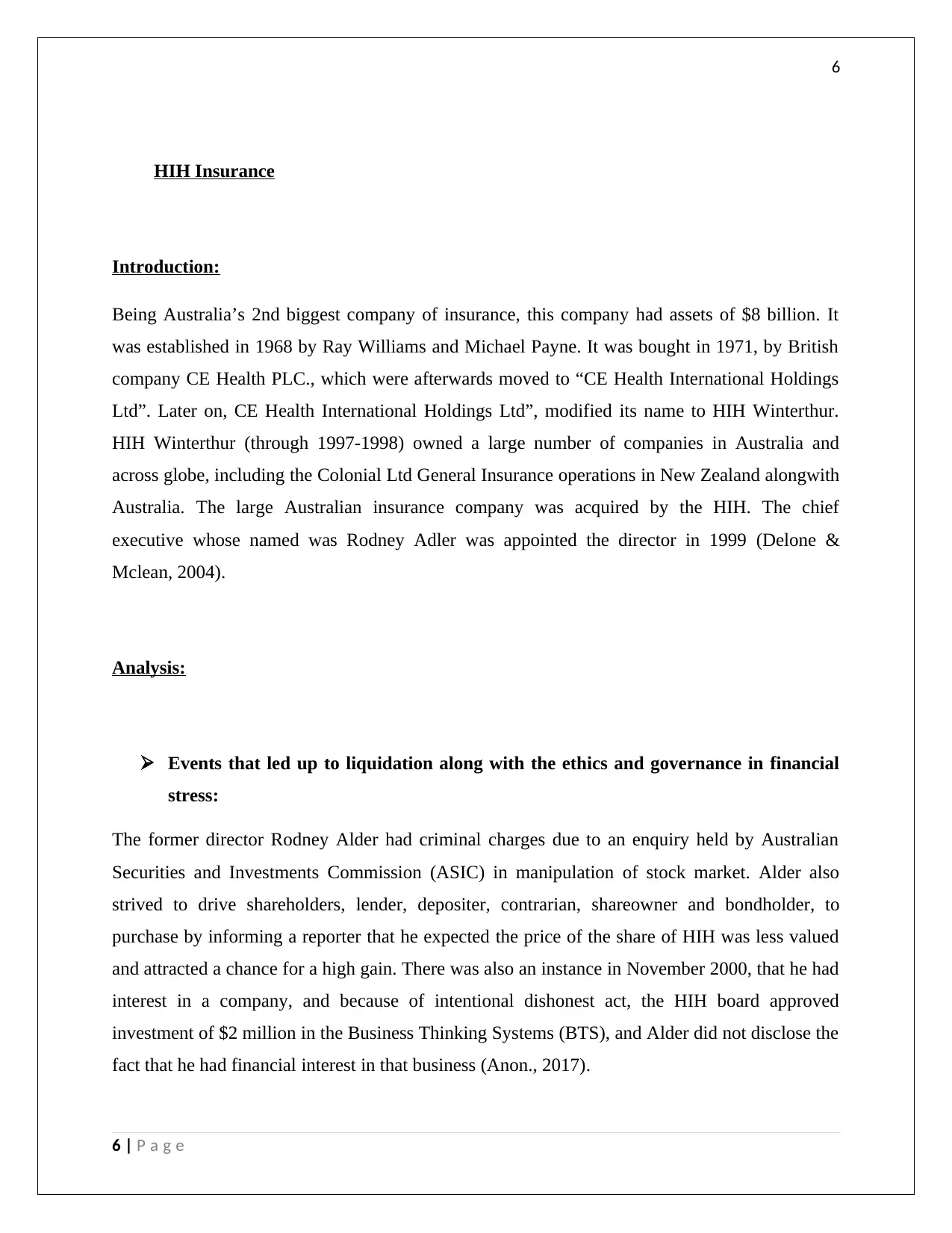
6
HIH Insurance
Introduction:
Being Australia’s 2nd biggest company of insurance, this company had assets of $8 billion. It
was established in 1968 by Ray Williams and Michael Payne. It was bought in 1971, by British
company CE Health PLC., which were afterwards moved to “CE Health International Holdings
Ltd”. Later on, CE Health International Holdings Ltd”, modified its name to HIH Winterthur.
HIH Winterthur (through 1997-1998) owned a large number of companies in Australia and
across globe, including the Colonial Ltd General Insurance operations in New Zealand alongwith
Australia. The large Australian insurance company was acquired by the HIH. The chief
executive whose named was Rodney Adler was appointed the director in 1999 (Delone &
Mclean, 2004).
Analysis:
Events that led up to liquidation along with the ethics and governance in financial
stress:
The former director Rodney Alder had criminal charges due to an enquiry held by Australian
Securities and Investments Commission (ASIC) in manipulation of stock market. Alder also
strived to drive shareholders, lender, depositer, contrarian, shareowner and bondholder, to
purchase by informing a reporter that he expected the price of the share of HIH was less valued
and attracted a chance for a high gain. There was also an instance in November 2000, that he had
interest in a company, and because of intentional dishonest act, the HIH board approved
investment of $2 million in the Business Thinking Systems (BTS), and Alder did not disclose the
fact that he had financial interest in that business (Anon., 2017).
6 | P a g e
HIH Insurance
Introduction:
Being Australia’s 2nd biggest company of insurance, this company had assets of $8 billion. It
was established in 1968 by Ray Williams and Michael Payne. It was bought in 1971, by British
company CE Health PLC., which were afterwards moved to “CE Health International Holdings
Ltd”. Later on, CE Health International Holdings Ltd”, modified its name to HIH Winterthur.
HIH Winterthur (through 1997-1998) owned a large number of companies in Australia and
across globe, including the Colonial Ltd General Insurance operations in New Zealand alongwith
Australia. The large Australian insurance company was acquired by the HIH. The chief
executive whose named was Rodney Adler was appointed the director in 1999 (Delone &
Mclean, 2004).
Analysis:
Events that led up to liquidation along with the ethics and governance in financial
stress:
The former director Rodney Alder had criminal charges due to an enquiry held by Australian
Securities and Investments Commission (ASIC) in manipulation of stock market. Alder also
strived to drive shareholders, lender, depositer, contrarian, shareowner and bondholder, to
purchase by informing a reporter that he expected the price of the share of HIH was less valued
and attracted a chance for a high gain. There was also an instance in November 2000, that he had
interest in a company, and because of intentional dishonest act, the HIH board approved
investment of $2 million in the Business Thinking Systems (BTS), and Alder did not disclose the
fact that he had financial interest in that business (Anon., 2017).
6 | P a g e
Paraphrase This Document
Need a fresh take? Get an instant paraphrase of this document with our AI Paraphraser
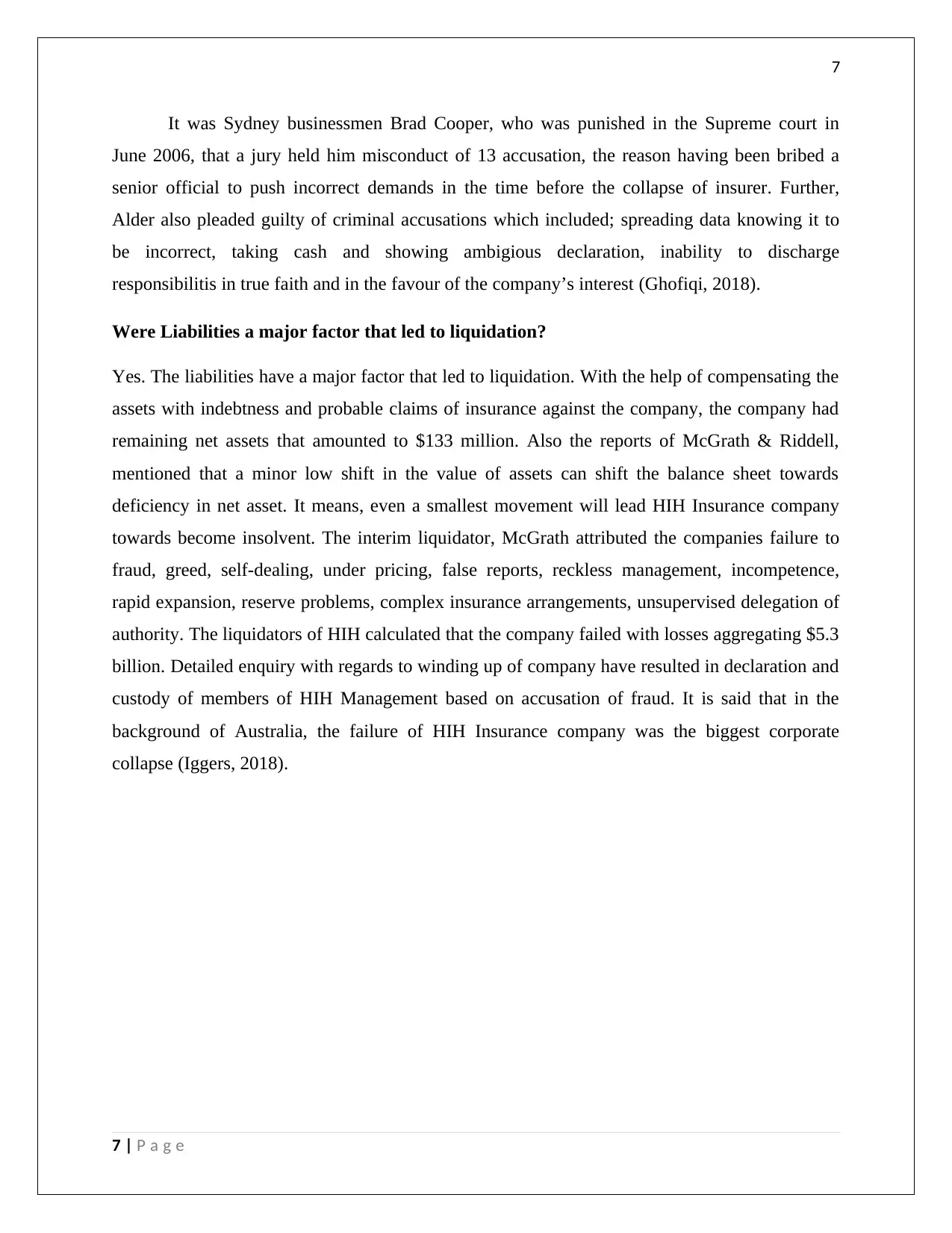
7
It was Sydney businessmen Brad Cooper, who was punished in the Supreme court in
June 2006, that a jury held him misconduct of 13 accusation, the reason having been bribed a
senior official to push incorrect demands in the time before the collapse of insurer. Further,
Alder also pleaded guilty of criminal accusations which included; spreading data knowing it to
be incorrect, taking cash and showing ambigious declaration, inability to discharge
responsibilitis in true faith and in the favour of the company’s interest (Ghofiqi, 2018).
Were Liabilities a major factor that led to liquidation?
Yes. The liabilities have a major factor that led to liquidation. With the help of compensating the
assets with indebtness and probable claims of insurance against the company, the company had
remaining net assets that amounted to $133 million. Also the reports of McGrath & Riddell,
mentioned that a minor low shift in the value of assets can shift the balance sheet towards
deficiency in net asset. It means, even a smallest movement will lead HIH Insurance company
towards become insolvent. The interim liquidator, McGrath attributed the companies failure to
fraud, greed, self-dealing, under pricing, false reports, reckless management, incompetence,
rapid expansion, reserve problems, complex insurance arrangements, unsupervised delegation of
authority. The liquidators of HIH calculated that the company failed with losses aggregating $5.3
billion. Detailed enquiry with regards to winding up of company have resulted in declaration and
custody of members of HIH Management based on accusation of fraud. It is said that in the
background of Australia, the failure of HIH Insurance company was the biggest corporate
collapse (Iggers, 2018).
7 | P a g e
It was Sydney businessmen Brad Cooper, who was punished in the Supreme court in
June 2006, that a jury held him misconduct of 13 accusation, the reason having been bribed a
senior official to push incorrect demands in the time before the collapse of insurer. Further,
Alder also pleaded guilty of criminal accusations which included; spreading data knowing it to
be incorrect, taking cash and showing ambigious declaration, inability to discharge
responsibilitis in true faith and in the favour of the company’s interest (Ghofiqi, 2018).
Were Liabilities a major factor that led to liquidation?
Yes. The liabilities have a major factor that led to liquidation. With the help of compensating the
assets with indebtness and probable claims of insurance against the company, the company had
remaining net assets that amounted to $133 million. Also the reports of McGrath & Riddell,
mentioned that a minor low shift in the value of assets can shift the balance sheet towards
deficiency in net asset. It means, even a smallest movement will lead HIH Insurance company
towards become insolvent. The interim liquidator, McGrath attributed the companies failure to
fraud, greed, self-dealing, under pricing, false reports, reckless management, incompetence,
rapid expansion, reserve problems, complex insurance arrangements, unsupervised delegation of
authority. The liquidators of HIH calculated that the company failed with losses aggregating $5.3
billion. Detailed enquiry with regards to winding up of company have resulted in declaration and
custody of members of HIH Management based on accusation of fraud. It is said that in the
background of Australia, the failure of HIH Insurance company was the biggest corporate
collapse (Iggers, 2018).
7 | P a g e
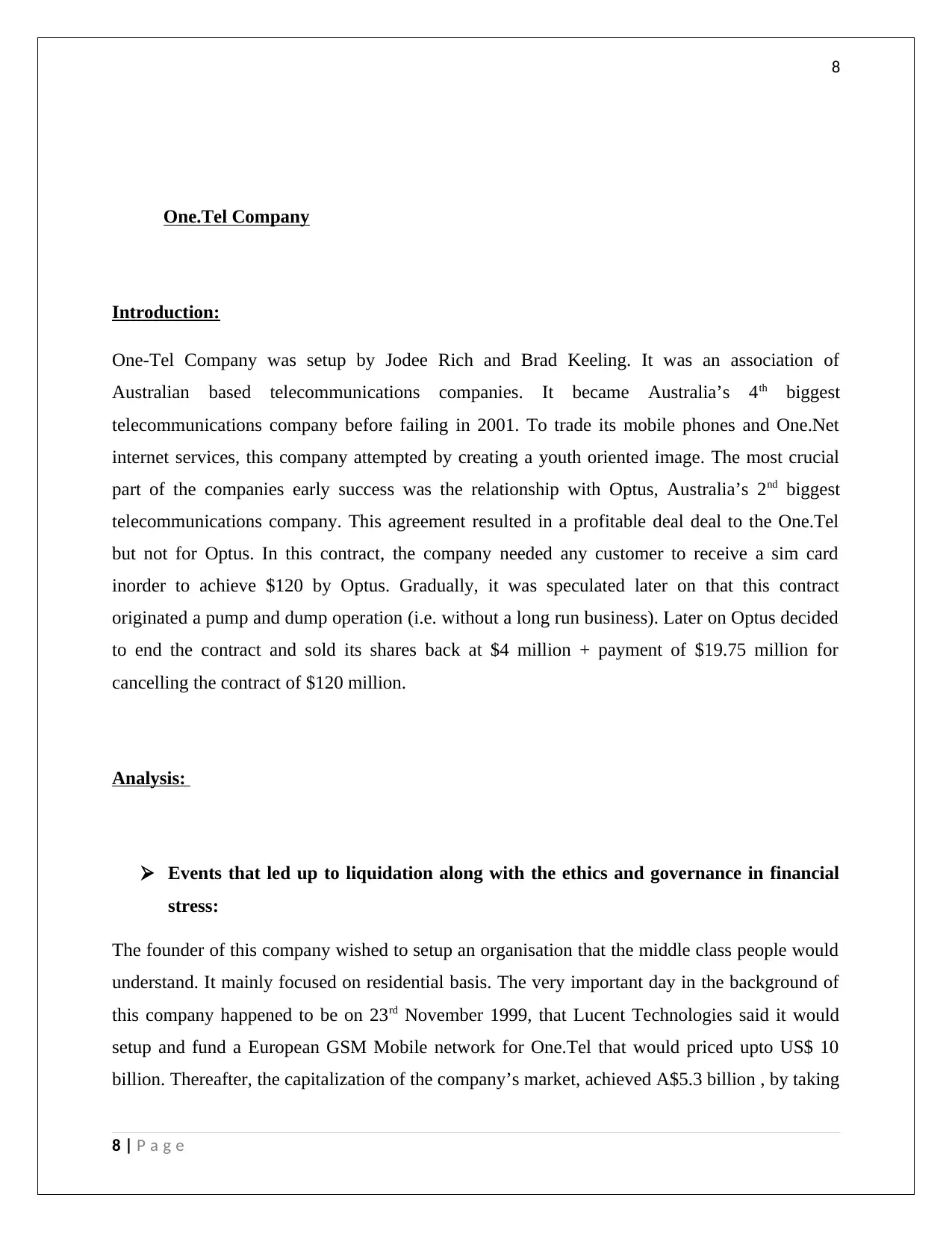
8
One.Tel Company
Introduction:
One-Tel Company was setup by Jodee Rich and Brad Keeling. It was an association of
Australian based telecommunications companies. It became Australia’s 4th biggest
telecommunications company before failing in 2001. To trade its mobile phones and One.Net
internet services, this company attempted by creating a youth oriented image. The most crucial
part of the companies early success was the relationship with Optus, Australia’s 2nd biggest
telecommunications company. This agreement resulted in a profitable deal deal to the One.Tel
but not for Optus. In this contract, the company needed any customer to receive a sim card
inorder to achieve $120 by Optus. Gradually, it was speculated later on that this contract
originated a pump and dump operation (i.e. without a long run business). Later on Optus decided
to end the contract and sold its shares back at $4 million + payment of $19.75 million for
cancelling the contract of $120 million.
Analysis:
Events that led up to liquidation along with the ethics and governance in financial
stress:
The founder of this company wished to setup an organisation that the middle class people would
understand. It mainly focused on residential basis. The very important day in the background of
this company happened to be on 23rd November 1999, that Lucent Technologies said it would
setup and fund a European GSM Mobile network for One.Tel that would priced upto US$ 10
billion. Thereafter, the capitalization of the company’s market, achieved A$5.3 billion , by taking
8 | P a g e
One.Tel Company
Introduction:
One-Tel Company was setup by Jodee Rich and Brad Keeling. It was an association of
Australian based telecommunications companies. It became Australia’s 4th biggest
telecommunications company before failing in 2001. To trade its mobile phones and One.Net
internet services, this company attempted by creating a youth oriented image. The most crucial
part of the companies early success was the relationship with Optus, Australia’s 2nd biggest
telecommunications company. This agreement resulted in a profitable deal deal to the One.Tel
but not for Optus. In this contract, the company needed any customer to receive a sim card
inorder to achieve $120 by Optus. Gradually, it was speculated later on that this contract
originated a pump and dump operation (i.e. without a long run business). Later on Optus decided
to end the contract and sold its shares back at $4 million + payment of $19.75 million for
cancelling the contract of $120 million.
Analysis:
Events that led up to liquidation along with the ethics and governance in financial
stress:
The founder of this company wished to setup an organisation that the middle class people would
understand. It mainly focused on residential basis. The very important day in the background of
this company happened to be on 23rd November 1999, that Lucent Technologies said it would
setup and fund a European GSM Mobile network for One.Tel that would priced upto US$ 10
billion. Thereafter, the capitalization of the company’s market, achieved A$5.3 billion , by taking
8 | P a g e
⊘ This is a preview!⊘
Do you want full access?
Subscribe today to unlock all pages.

Trusted by 1+ million students worldwide
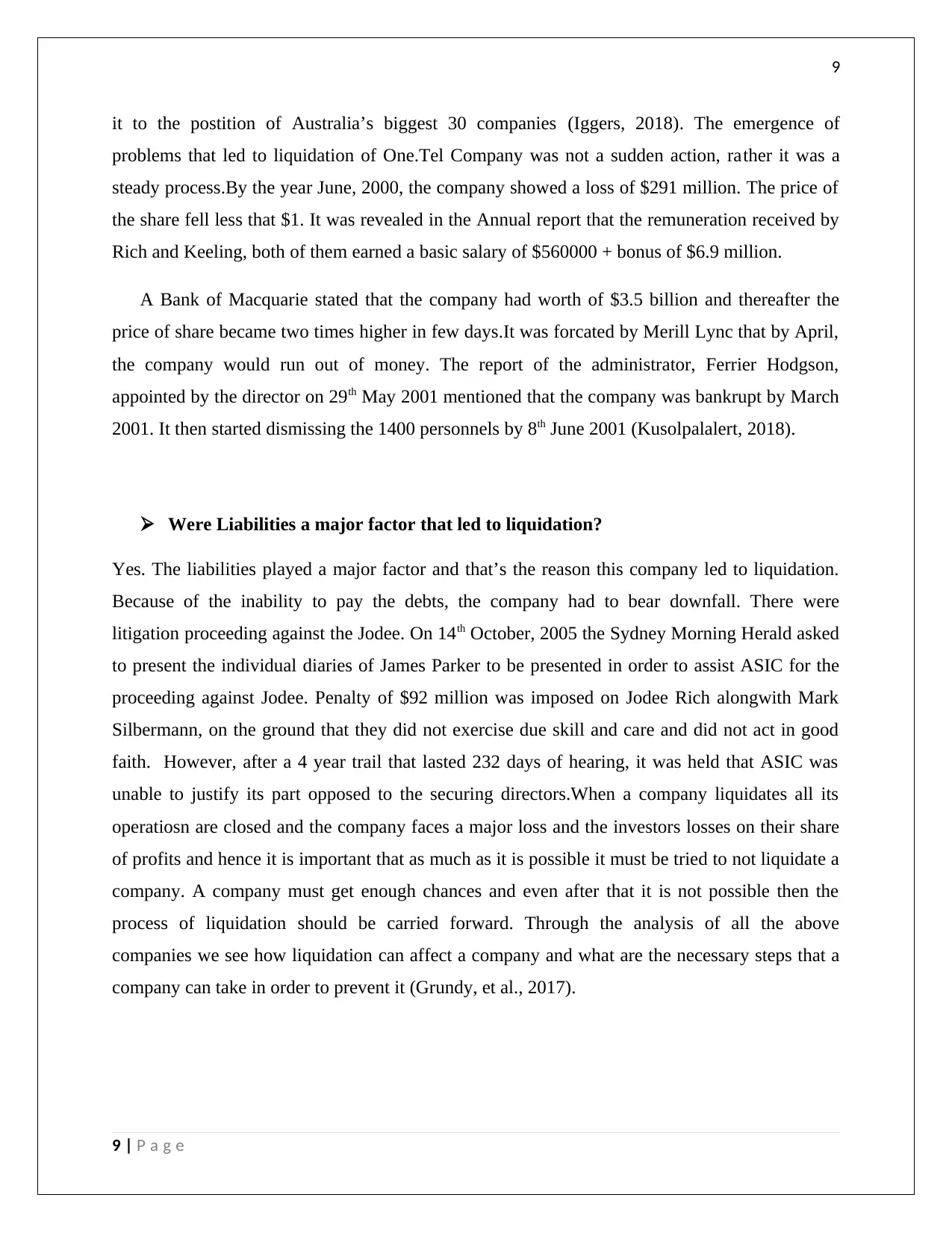
9
it to the postition of Australia’s biggest 30 companies (Iggers, 2018). The emergence of
problems that led to liquidation of One.Tel Company was not a sudden action, rather it was a
steady process.By the year June, 2000, the company showed a loss of $291 million. The price of
the share fell less that $1. It was revealed in the Annual report that the remuneration received by
Rich and Keeling, both of them earned a basic salary of $560000 + bonus of $6.9 million.
A Bank of Macquarie stated that the company had worth of $3.5 billion and thereafter the
price of share became two times higher in few days.It was forcated by Merill Lync that by April,
the company would run out of money. The report of the administrator, Ferrier Hodgson,
appointed by the director on 29th May 2001 mentioned that the company was bankrupt by March
2001. It then started dismissing the 1400 personnels by 8th June 2001 (Kusolpalalert, 2018).
Were Liabilities a major factor that led to liquidation?
Yes. The liabilities played a major factor and that’s the reason this company led to liquidation.
Because of the inability to pay the debts, the company had to bear downfall. There were
litigation proceeding against the Jodee. On 14th October, 2005 the Sydney Morning Herald asked
to present the individual diaries of James Parker to be presented in order to assist ASIC for the
proceeding against Jodee. Penalty of $92 million was imposed on Jodee Rich alongwith Mark
Silbermann, on the ground that they did not exercise due skill and care and did not act in good
faith. However, after a 4 year trail that lasted 232 days of hearing, it was held that ASIC was
unable to justify its part opposed to the securing directors.When a company liquidates all its
operatiosn are closed and the company faces a major loss and the investors losses on their share
of profits and hence it is important that as much as it is possible it must be tried to not liquidate a
company. A company must get enough chances and even after that it is not possible then the
process of liquidation should be carried forward. Through the analysis of all the above
companies we see how liquidation can affect a company and what are the necessary steps that a
company can take in order to prevent it (Grundy, et al., 2017).
9 | P a g e
it to the postition of Australia’s biggest 30 companies (Iggers, 2018). The emergence of
problems that led to liquidation of One.Tel Company was not a sudden action, rather it was a
steady process.By the year June, 2000, the company showed a loss of $291 million. The price of
the share fell less that $1. It was revealed in the Annual report that the remuneration received by
Rich and Keeling, both of them earned a basic salary of $560000 + bonus of $6.9 million.
A Bank of Macquarie stated that the company had worth of $3.5 billion and thereafter the
price of share became two times higher in few days.It was forcated by Merill Lync that by April,
the company would run out of money. The report of the administrator, Ferrier Hodgson,
appointed by the director on 29th May 2001 mentioned that the company was bankrupt by March
2001. It then started dismissing the 1400 personnels by 8th June 2001 (Kusolpalalert, 2018).
Were Liabilities a major factor that led to liquidation?
Yes. The liabilities played a major factor and that’s the reason this company led to liquidation.
Because of the inability to pay the debts, the company had to bear downfall. There were
litigation proceeding against the Jodee. On 14th October, 2005 the Sydney Morning Herald asked
to present the individual diaries of James Parker to be presented in order to assist ASIC for the
proceeding against Jodee. Penalty of $92 million was imposed on Jodee Rich alongwith Mark
Silbermann, on the ground that they did not exercise due skill and care and did not act in good
faith. However, after a 4 year trail that lasted 232 days of hearing, it was held that ASIC was
unable to justify its part opposed to the securing directors.When a company liquidates all its
operatiosn are closed and the company faces a major loss and the investors losses on their share
of profits and hence it is important that as much as it is possible it must be tried to not liquidate a
company. A company must get enough chances and even after that it is not possible then the
process of liquidation should be carried forward. Through the analysis of all the above
companies we see how liquidation can affect a company and what are the necessary steps that a
company can take in order to prevent it (Grundy, et al., 2017).
9 | P a g e
Paraphrase This Document
Need a fresh take? Get an instant paraphrase of this document with our AI Paraphraser
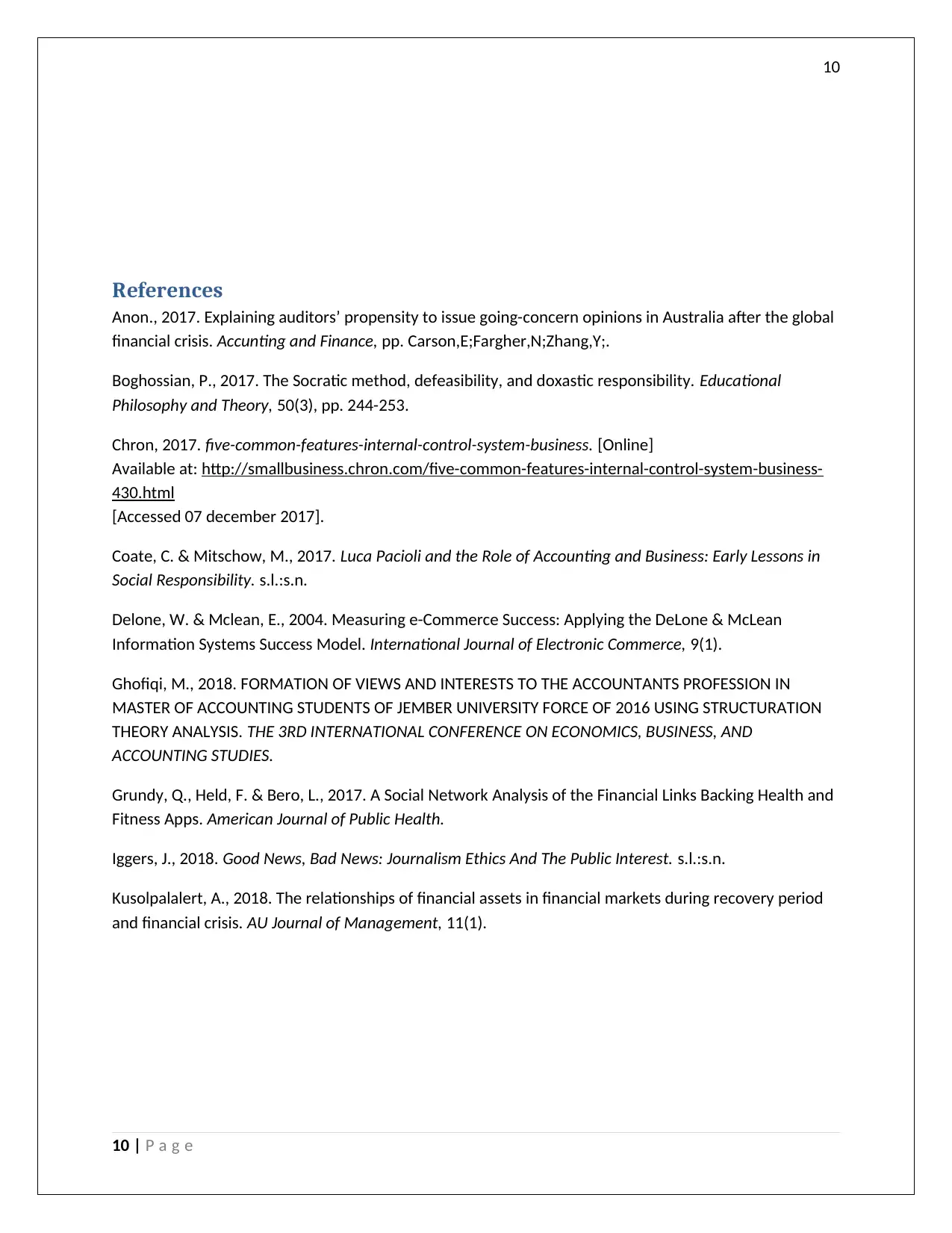
10
References
Anon., 2017. Explaining auditors’ propensity to issue going-concern opinions in Australia after the global
financial crisis. Accunting and Finance, pp. Carson,E;Fargher,N;Zhang,Y;.
Boghossian, P., 2017. The Socratic method, defeasibility, and doxastic responsibility. Educational
Philosophy and Theory, 50(3), pp. 244-253.
Chron, 2017. five-common-features-internal-control-system-business. [Online]
Available at: http://smallbusiness.chron.com/five-common-features-internal-control-system-business-
430.html
[Accessed 07 december 2017].
Coate, C. & Mitschow, M., 2017. Luca Pacioli and the Role of Accounting and Business: Early Lessons in
Social Responsibility. s.l.:s.n.
Delone, W. & Mclean, E., 2004. Measuring e-Commerce Success: Applying the DeLone & McLean
Information Systems Success Model. International Journal of Electronic Commerce, 9(1).
Ghofiqi, M., 2018. FORMATION OF VIEWS AND INTERESTS TO THE ACCOUNTANTS PROFESSION IN
MASTER OF ACCOUNTING STUDENTS OF JEMBER UNIVERSITY FORCE OF 2016 USING STRUCTURATION
THEORY ANALYSIS. THE 3RD INTERNATIONAL CONFERENCE ON ECONOMICS, BUSINESS, AND
ACCOUNTING STUDIES.
Grundy, Q., Held, F. & Bero, L., 2017. A Social Network Analysis of the Financial Links Backing Health and
Fitness Apps. American Journal of Public Health.
Iggers, J., 2018. Good News, Bad News: Journalism Ethics And The Public Interest. s.l.:s.n.
Kusolpalalert, A., 2018. The relationships of financial assets in financial markets during recovery period
and financial crisis. AU Journal of Management, 11(1).
10 | P a g e
References
Anon., 2017. Explaining auditors’ propensity to issue going-concern opinions in Australia after the global
financial crisis. Accunting and Finance, pp. Carson,E;Fargher,N;Zhang,Y;.
Boghossian, P., 2017. The Socratic method, defeasibility, and doxastic responsibility. Educational
Philosophy and Theory, 50(3), pp. 244-253.
Chron, 2017. five-common-features-internal-control-system-business. [Online]
Available at: http://smallbusiness.chron.com/five-common-features-internal-control-system-business-
430.html
[Accessed 07 december 2017].
Coate, C. & Mitschow, M., 2017. Luca Pacioli and the Role of Accounting and Business: Early Lessons in
Social Responsibility. s.l.:s.n.
Delone, W. & Mclean, E., 2004. Measuring e-Commerce Success: Applying the DeLone & McLean
Information Systems Success Model. International Journal of Electronic Commerce, 9(1).
Ghofiqi, M., 2018. FORMATION OF VIEWS AND INTERESTS TO THE ACCOUNTANTS PROFESSION IN
MASTER OF ACCOUNTING STUDENTS OF JEMBER UNIVERSITY FORCE OF 2016 USING STRUCTURATION
THEORY ANALYSIS. THE 3RD INTERNATIONAL CONFERENCE ON ECONOMICS, BUSINESS, AND
ACCOUNTING STUDIES.
Grundy, Q., Held, F. & Bero, L., 2017. A Social Network Analysis of the Financial Links Backing Health and
Fitness Apps. American Journal of Public Health.
Iggers, J., 2018. Good News, Bad News: Journalism Ethics And The Public Interest. s.l.:s.n.
Kusolpalalert, A., 2018. The relationships of financial assets in financial markets during recovery period
and financial crisis. AU Journal of Management, 11(1).
10 | P a g e

11
11 | P a g e
11 | P a g e
⊘ This is a preview!⊘
Do you want full access?
Subscribe today to unlock all pages.

Trusted by 1+ million students worldwide
1 out of 13
Related Documents
Your All-in-One AI-Powered Toolkit for Academic Success.
+13062052269
info@desklib.com
Available 24*7 on WhatsApp / Email
![[object Object]](/_next/static/media/star-bottom.7253800d.svg)
Unlock your academic potential
Copyright © 2020–2025 A2Z Services. All Rights Reserved. Developed and managed by ZUCOL.





